When you’re learning BJJ basics you’ve got to become familiar with the most common techniques first – they are the low hanging fruit and also the techniques that you’re going to face most often on the mat. The Leg Weave Guard Pass is one of the most typical ways to pass the Guard so you better have a good answer for it!
Here’s a simple and effective way to stop, and then counterattack, when your opponent tries to smash your guard using the Leg Weave Pass.
A basic idea in BJJ is to use your legs to control your opponent if you’re on your back. In this scenario, we’re using Half Guard to stop our partner from smashing us down with their weight.
A powerful variation of Half Guard is called Shin Shield. This is where you’re using my top shin as a wall to prevent your training partner from getting too close to your neck or from getting too heavy on top of your torso.
When you’re learning BJJ basics, you’ll start to see how Jiu Jitsu is about removing walls and obstacles so that you can secure a specific position to start attacking your submissions.
In this picture series (and video above), my partner Stephan beginning to dismantle my Half Guard Shin Shield by using a Leg Weave control. The Leg Weave control is only viable if it’s combined with shoulder pressure from Stephan’s right shoulder.
If you’re in this position your main concern is to stop the top man from crushing down on your top leg with his right shoulder. Thus you need to recognise that his right hand going under your top leg and over bottom leg is an immediate threat.
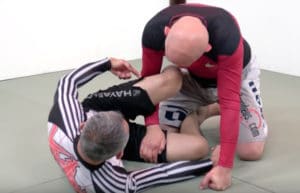
Stephan setting up the leg weave pass
Right away you need to push the top man’s right shoulder with your left hand. Next shrimp and pike your hips up, driving your hips up to the sky while keeping your right shoulder on the ground.
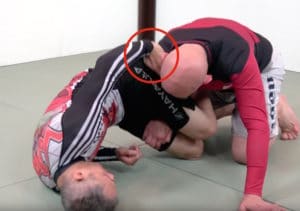
Pike hips up and block shoulder
Shrimping is a BJJ basics movement that you’ll use in virtually every bottom technique in Jiu Jitsu. By shrimping and by moving your hips up to the ceiling you’ve changed the direction of how the top man can drive in with his right shoulder.
Then as soon as you can, you need to take apart your partner’s control of your bottom leg. Use your top hand to peel his hand off your bottom thigh, pushing it through your legs.
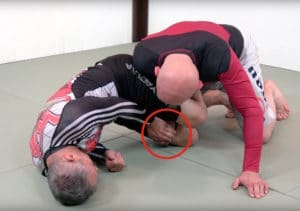
Place hand over his hand…
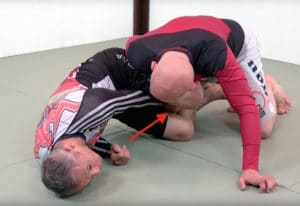
…and push his hand off your thigh to break grip and free leg
Leg isolation and hip control is the foundational skill for guard passing for the top player. And conversely leg dexterity and hip mobility is the corner stone of solid guard retention for the bottom player in BJJ.
BJJ basics are about understanding the underlying concepts behind the techniques. When you understand that guard passing and guard retention are simply a battle for hip control and hip mobility; then your BJJ skills will skyrocket.
Now, back to countering the leg weave pass…
Since his right arm isn’t entangling your legs anymore, you can easily move your right leg. That means you can use your top leg to attack the other man’s arm. By smashing down on his right shoulder with your left knee, you ruin his posture, his ability to pass guard, and his resistance to your submission attacks.
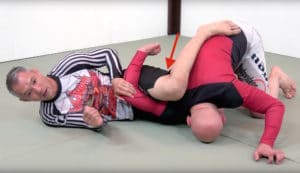
Drive knee down behind his shoulder to ruin his posture
With his right arm isolated you can apply an Omoplata or, my personal favourite from this position, the Kimura shoulder lock.
Apply the Kimura by controlling his securing his right hand and encircling his right arm with your right arm arm to find your left wrist. By driving his hand up to the ceiling, you’ll be able to tap him out with the Kimura shoulder lock.
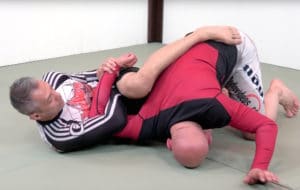
The Kimura armlock, a great followup for this technique
Stopping the Leg Weave Guard Pass and then counter the Guard Pass with the Kimura shoulder lock is just one example of how Jiu Jitsu works during a real life sparring or rolling scenario.
Your opponent attacks, you defend, and then you launch an attack of your own.
Jiu Jitsu is like a conversation of questions and answers and of sweeps and submissions.
Hope this helps you defend your guard and tap out more sparring partners!
About the author: Ritchie Yip is a BJJ black belt and teaches jiu-jitsu at his school, Infighting MMA in Vancouver BC.
How to Develop an Impassable Guard
To help you make your guard much harder to pass check out The Guard Retention Formula that I filmed with BJJ black belt Rory Van Vliet.
In this conceptually grounded instructional you’ll get step-by-step methods to stop all of the most common and most powerful guard passes, including the knee cut, toreando, smash pass, over-under, leg drag, double unders, and more.
It’s incredibly extensive and will have gi, no gi, MMA and self defense applications.
As we were filming it I kept on thinking that if I had had this material as a white belt I would have had an absolutely impassible guard. It would have taken years off of my learning curve.
I’ve been a black belt now for almost 14 years and I still learned a ton from Rory’s teachings. I’ve already used some of the techniques and approaches in my own sparring and it has really helped.
So I can confidently say that this instructional will help everyone from white belt to black belt.
This is the best resource on the topic of guard retention that I have ever seen.
Click here for more information about The Guard Retention Formula!
The post How to Defend the Leg Weave Guard Pass appeared first on Grapplearts.

